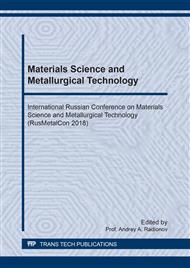[1]
International Institute of Welding. Casebook of brittle fracture failures. I.I.W., DC IX-753-71, Sub Commission XD, (1971).
Google Scholar
[2]
V.A. Vinokurov, A.G. Grigoryants, Theory of welding deformations and stresses, Moscow: Mechanical Engineering, (1984).
Google Scholar
[3]
V.I. Makhnenko The development of the theory of welding stresses and deformations, Proceedings of the All-Union Symposium on Residual Stresses and Control Methods, Moscow: AS USSR, (1982) 271-294.
Google Scholar
[4]
V.S. Ignatieva, Stress state of elements of metal structures in the field of multilayered welds, In the book. Development of Metal Constructions: Works of N.Streletskiy's School, V.V. Kuznetsov, E.I. Belenya and others; Ed. V.V. Kuznetsov, Moscow: Stroyizdat, (1987) 96-105.
Google Scholar
[5]
E.V. Kolomiytsev, Influence of residual stresses and properties of HAZ metal on fatigue of welded joints in a corrosive environment, Automatic welding, 9 (1990) 5-8.
Google Scholar
[6]
V.S. Girenko, V.I. Kiryan, Analysis of the influence of residual stresses on the strength of welded joints, Automatic welding, 12 (1975) 1-5.
Google Scholar
[7]
I.I. Trush, M.F. Berezhnitskaya, About the influence of residual stresses on the initial development of small cracks near welded joints, Phys. mechanics of materials, 6 (1986) 55-58.
Google Scholar
[8]
R.G. Gubaydulin, A.K. Tinggaev, M.R. Gubaydulin, E.V. Pshenichnikova, Influence of technological and operational factors on the bearing capacity of welded joints of offshore fixed platforms, Technology of shipbuilding, 9 (1990) 79-84.
Google Scholar
[9]
R.G. Gubaydulin, S.G. Ivanov, A.K. Tingaev, et al., Residual stresses in welded elements of offshore fixed platforms, Automatic welding, 8 (1989) 39-41.
Google Scholar
[10]
O.N. Mikhailov, Hole method, Residual stresses in workpieces and details of large machines, Sverdlovsk: NIITYAZHMASH Uralmashzavod, (1971) 3-33.
Google Scholar
[11]
ASTM E 837-08. Standard Test Method for Determining Residual Stresses by the Hole-Drilling Strain-Gage Method, (2008).
DOI: 10.1520/e0837-13
Google Scholar
[12]
N.I. Muskhelishvili, Some basic problems of the mathematical theory of elasticity, Moscow, Nauka, (1966).
Google Scholar
[13]
R.A. Makarov, L.B. Rensky and others, Strain gauges in mechanical engineering: A reference book, Moscow: Mechanical Engineering, (1975).
Google Scholar
[14]
L.S. Livshits. Metallurgy of welding and heat treatment of welded joints, Moscow, Mechanical Engineering, (1989).
Google Scholar
[15]
SP 70.13330.2012 Bearing and enclosing structures. The updated version of SNiP 3.03.01-87.- Moscow: Stroyinformizdat, (2012).
Google Scholar
[16]
SP 53-101-98. Manufacture and quality control of steel building structures, Moscow, Gosstroy of Russia, State Unitary Enterprise of the Central Prudential Center, (1999).
Google Scholar
[17]
BS EN 1011-2: 2001 Welding. Recommendations for welding of metallic materials. Arc welding of ferritic steels, (2003).
DOI: 10.3403/02065964u
Google Scholar
[18]
V.I. Panov, Influence of temperature of heating and heat treatment on residual stresses, Welding production, 10 (1990) 113-15.
Google Scholar
[19]
Y.C. Lin, C.P. Chou, Journal of Materials Processing Technology. 48(1-4) (1995) 693–698.
Google Scholar
[20]
R.G. Gubaidulin, A.K. Tingaev, V.A. Lupin. Stressed state of welded joints of tubular units without gusset plate, Bulletin of the South Ural State University. Series «Metallurgy», 15 (2012) ISSUE 18, 31-36.
Google Scholar


